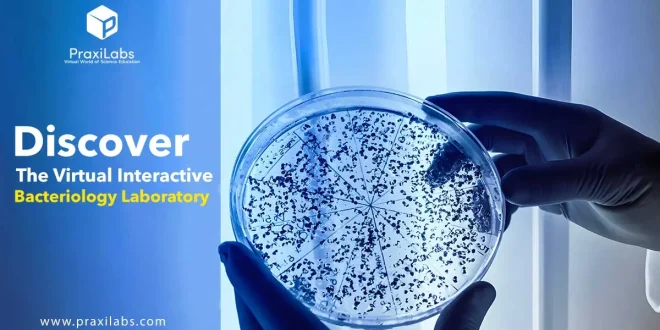Last Updated on October 26, 2025 by Muhamed Elmesery
Virtual interactive bacteriology laboratory is developed to allow students to learn and conduct a variety of experiments that are typically performed in diagnostic bacteriology laboratory to detect and identify bacterial pathogens from patient samples.
In this blog post we will dive into the world of virtual interactive bacteriology laboratory, the key concepts, how bacteriology simulations enhance practical skills, examples of available bacteriology tests in PraxiLabs, and more!
Table of Contents
What is virtual interactive bacteriology laboratory?
Virtual interactive bacteriology laboratory is a computer-based simulation that replicates the real bacteriology laboratory. These simulations allow students to identify and differentiate between bacterial species, Learn and perform several bacteriology laboratory tests in virtual environment with features such as:
- Immersive and interactive 3D experience.
- Cost-effective.
- Safe and away from any hazards (e.g., pathogens).
- Aligned with all learning styles.
- Available anywhere, anytime.
Pick the Best Virtual Plan For You
What are the tests done in bacteriology?
In bacteriology, there are several categories of tests that are done to detect, classify, differentiate between bacteria or diagnose pathogens.
The following table summarizes the main categories of tests done in bacteriology:
| Tests | Purpose | Examples |
| Biochemical tests | Detect the enzymatic activity and metabolic reactions of bacteria. |
|
| Staining procedures | Observe the characteristics of bacteria, and differentiate between bacterial species. |
|
| Molecular tests | Classify and identify bacteria precisely. |
|
| Bacteria culture tests | Isolate and grow bacteria. |
|
| Antibiotic sensitivity tests | Examine the sensitivity of bacteria to antibiotics. |
|
Key concepts of virtual interactive bacteriology laboratory
The key concept of a virtual interactive bacteriology lab is to gain a clear understanding by imagining and visualizing what happens inside bacteria and other microorganisms at the microscopic level. This enhances the students’ visual perception and observational skills.
Other Key Concepts of Virtual Interactive Bacteriology Laboratory:
1. Hands on simulation of Real-Life Lab Procedures
Virtual bacteriology laboratory simulates real bacteriology experiments, allowing students to:
- Perform staining and culturing techniques.
- Run biochemical tests.
- Analyze results just as they would in real-world settings.
Example: Bacterial plating technique – Streak plate virtual lab \ Bacteria growth virtual lab \ Virtual bacterial transformation lab
2. Safe and Risk-Free Environment
Students can practice potentially hazardous lab techniques without exposure to real pathogens or chemicals.
Virtual bacteriology laboratory is ideal for beginners, no need for expensive equipment or dedicated safety labs.
3. Interactive Learning Experience
Virtual labs are not just videos — they’re fully interactive and immersive, guiding students to:
- Select materials and reagents.
- Make decisions.
- Receive instant feedback and corrections.
This enhances the students’ retention, engagement, and critical thinking.
4. Bacterial Identification and differentiation Protocols
Virtual labs train students to identify unknown bacteria through:
- Staining procedures.
- Step-by-step biochemical test selection.
- Logical deduction and decision-making.
Bacterial identification virtual lab simulates real diagnostic workflows in clinical microbiology.
5. Reproducibility and Repetition
Students can repeat experiments anytime, anywhere, which supports:
- Mastery through practice.
- Learning from mistakes.
- Self-paced education.
For more understanding, You can try PraxiLabs virtual lab .. Create your free account now and try it!
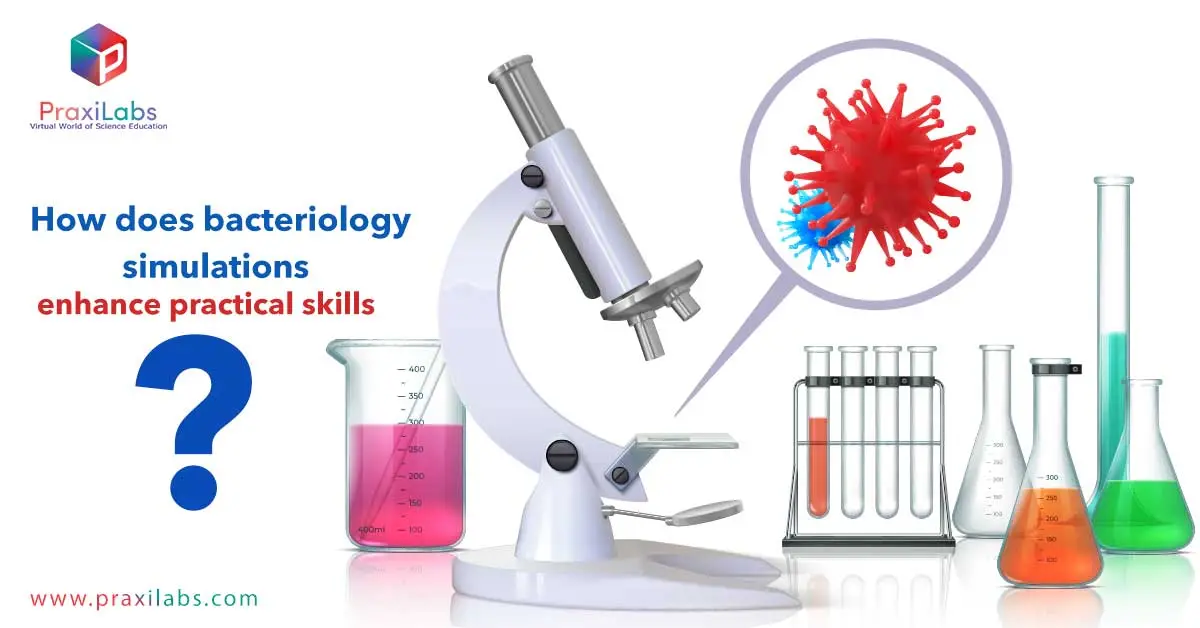
How does bacteriology simulations enhancing practical skills?
Bacteriology simulations enhance practical skills by providing a virtual environment with features such as safety, repeatability, flexibility, engagement, and more- all of which increase the students’ learning outcomes and practical skills.
A study conducted in Denmark showed that using virtual laboratory simulation helped the learners connect theory with practice, learn the procedures and techniques while enhancing their engagement and interest.
Applying Kolb’s experiential learning theory to virtual laboratory experience: when the students actively experiment in the virtual lab, they build concrete learning experiences. As they reflect on their experiments and observations, they can understand the concepts and improve in the next cycle.
Visit Our Ever-Expanding Catalog of 3D science experiments and Enhance Your Students’ Learning Outcomes!
Examples of available bacteriology tests in Praxilabs
PraxiLabs provides a range of bacteriology tests that allow students to identify, classify, and differentiate bacterial species to study them and diagnose several infections.
Let’s discover some examples of available bacteriology tests in PraxiLabs:
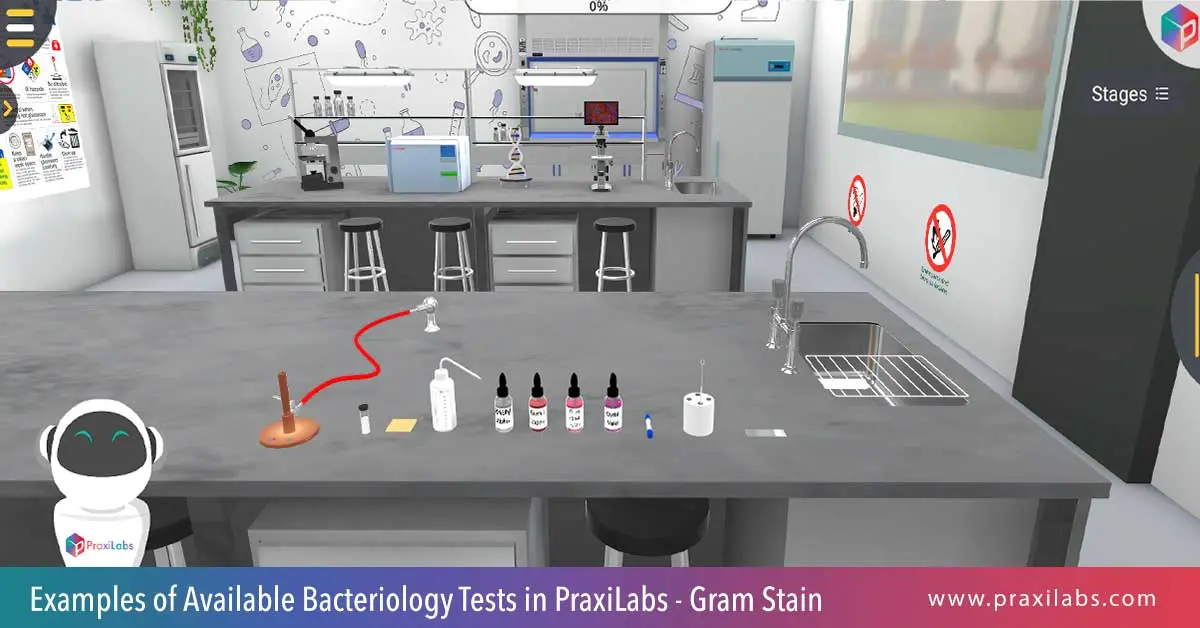
Gram Stain
The Gram staining technique is used to differentiate bacteria into two groups: Gram-positives and Gram-negatives. It involves the following steps:
- Labeling of the slides.
- Preparing the smear.
- Heat Fixation.
- Gram Staining Procedure.
By the end of gram stain simulation, your students will be able to:
- Become proficient at performing the gram stain consistently and accurately.
- Differentiate between various shapes, sizes, arrangements, and gram reactions of bacteria.
- Distinguish between the two major categories of bacteria: Gram-positive and Gram-negative.
- Understand how the Gram stain reaction affects Gram-positive and Gram-negative bacteria based on the biochemical and structural differences of their cell walls.
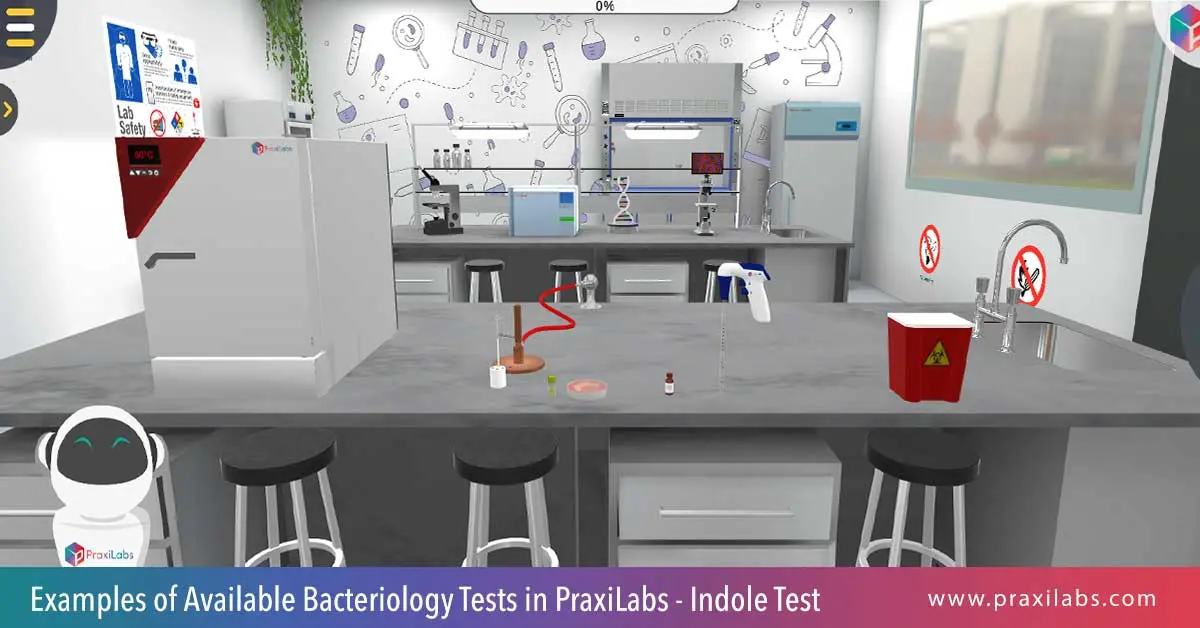
Indole Test
The Indole test is used to detect the presence of enteric bacteria. It is performed on bacterial species to determine the ability of the organism to convert tryptophan into indole.
By using Indole test virtual lab, you can teach your students how to:
- Perform the Indole test consistently and accurately.
- Determine if an organism possesses the tryptophanase enzyme.
- Differentiate Proteus mirabilis (indole-negative) from all other Proteus species (indole-positive).
- Differentiate Klebsiella pneumoniae (indole-negative) from Klebsiella oxytoca (indole-positive).
- Differentiate Citrobacter freundii (indole-negative) from Citrobacter koseri (indole positive).
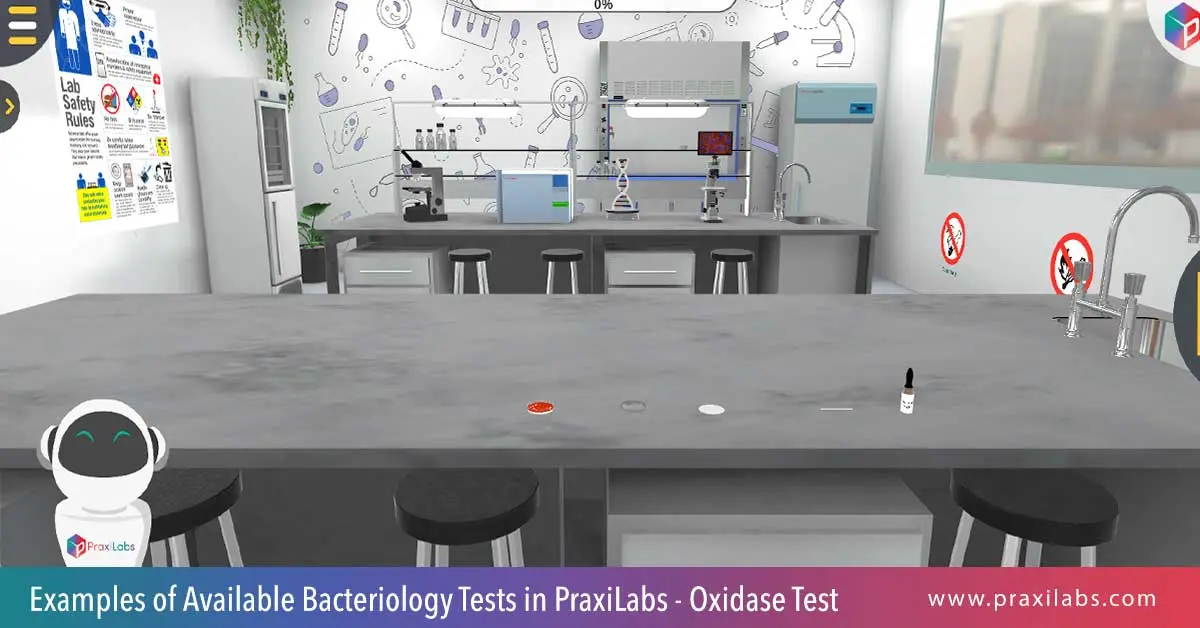
Oxidase Test
The Oxidase test assays for the presence of the enzyme cytochrome oxidase in bacteria.
Help your students understand how to:
- Perform the Oxidase test consistently and accurately.
- Determine if an organism possesses the cytochrome oxidase enzyme.
- Differentiate Neisseria, Moraxella, Campylobacter, and Pasteurella species (oxidase positive) from other bacteria.
- Differentiate Pseudomonads from related species.
PraxiLabs provides instant and unlimited access to several simulations you may need from anywhere, without the hassle of going to the laboratory. Let your young scientists enjoy their journey, anytime!
Frequently Asked Questions
What is done in a bacteriology lab?
In bacteriology lab, several tests are performed on bacteria such as:
1- Biochemical tests (e.g., Indole test – Oxidase test).
2- Culture tests ( e.g., Streak plate technique).
3- Staining techniques (e.g., Gram stain).
Are virtual bacteriology labs suitable for high schools?
Yes! Virtual bacteriology labs are suitable for high schools and can help students classify and differentiate between bacterial species in a safe, interactive, and immersive 3D environment which enhances their learning outcome and skills.
 PraxiLabs A virtual world of science
PraxiLabs A virtual world of science

